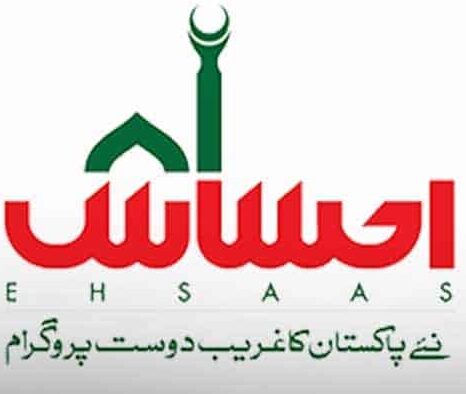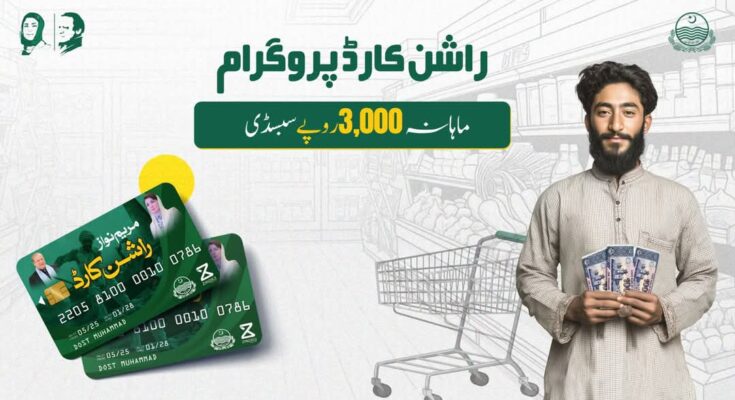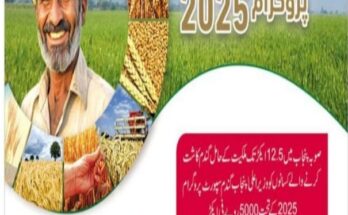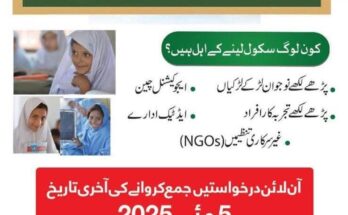Introduction
The Rashan Card Program 2025: In a transformative step toward alleviating poverty and addressing food insecurity in Punjab, Pakistan, Chief Minister Maryam Nawaz Sharif launched the Rashan Card Program 2025, a pioneering welfare scheme designed to provide essential food support to low-income families. Officially commencing on May 1, 2025, this initiative is touted as Pakistan’s largest ration card program, aimed at supporting approximately 1.25 to 1.5 million underprivileged households across the province. By offering monthly subsidies and financial assistance, the program seeks to ensure that vulnerable populations, particularly daily wage earners and laborers, can access basic kitchen essentials amidst rising inflation and economic challenges. This article delves into the intricacies of the Rashan Card Program 2025, exploring its objectives, eligibility criteria, registration process, benefits, and broader implications for Punjab’s socio-economic landscape.
Background and Context
Pakistan has faced significant economic challenges in recent years, with inflation rates soaring and household budgets strained, particularly for low-income families. The cost of basic food items such as flour, sugar, pulses, and cooking oil has risen sharply, making it difficult for many to afford daily necessities. Recognizing these hardships, the Punjab government, under the leadership of Maryam Nawaz, has prioritized social welfare initiatives to provide relief to the province’s most vulnerable citizens. The Rashan Card Program 2025 builds on earlier welfare efforts, such as the Ramadan Rashan Package and the 8070 Relief Program, but introduces a more structured, long-term approach to food security.
Maryam Nawaz’s vision for the program aligns with her broader agenda of creating a welfare state in Punjab. By targeting the labor class, daily wage earners, and other low-income groups, the initiative addresses the immediate needs of those most affected by economic instability. Additionally, the program is part of a comprehensive strategy that includes other schemes like the Nigehban Card, Himmat Card, and low-cost housing projects, reflecting a holistic approach to poverty alleviation and social equity.
Objectives of the Rashan Card Program 2025
The primary objective of the Rashan Card Program 2025 is to provide financial relief to low-income households by subsidizing the cost of essential food items. The program aims to:
- Combat Food Insecurity: Ensure that deserving families have access to basic nutrition, reducing the risk of hunger and malnutrition.
- Alleviate Economic Pressure: Offer monthly subsidies to ease the financial burden on households struggling with inflation.
- Promote Social Equity: Prioritize marginalized groups, including laborers, daily wage earners, and minority communities, to foster inclusivity.
- Establish a Sustainable Welfare System: Create a scalable model that can be expanded to benefit more families in the future, based on available resources.
- Enhance Transparency and Accessibility: Streamline registration and distribution processes through digital platforms like the Punjab Socio-Economic Registry (PSER) to ensure fairness and efficiency.
By addressing these goals, the program seeks to empower Punjab’s poorest citizens and provide them with a safety net to navigate economic hardships.
Key Features of the Program
The Rashan Card Program 2025 is distinguished by its innovative design and citizen-centric approach. Key features include:
- Monthly Subsidy: Eligible families receive a monthly subsidy of Rs. 3,000 to Rs. 5,000, depending on the specific scheme, to purchase essential food items like flour, sugar, rice, lentils, and ghee from registered utility stores and partner outlets. Some sources indicate a financial assistance package of Rs. 10,000 over four months for certain beneficiaries.
- Rashan Card and Nigehban Card: The program issues government-issued cards, including the Rashan Card and the Nigehban Card, which can be used at designated stores equipped with Point of Sale (POS) systems to deduct subsidies. The Nigehban Card is part of a broader welfare expansion targeting an additional 3 million people.
- Focus on Laborers and Miners: Social security workers, miners, and daily wage earners are prioritized, with the program offering additional benefits such as a 20% discount on food items and access to 13 other facilities, including healthcare and social security services.
- PSER Registration: Eligibility is determined through the Punjab Socio-Economic Registry (PSER) survey, a mandatory requirement to ensure that only deserving households benefit. The PSER portal (pser.punjab.gov.pk) facilitates online registration and status checks.
- Transparency and Efficiency: The program emphasizes queue-free registration and distribution, with digital tools like the 8070 SMS code for eligibility verification and a dedicated helpline for support.
- Scalability: The initiative plans to expand its reach beyond the initial 1.25 to 1.5 million families, with the potential to include more beneficiaries based on government resources.
These features make the Rashan Card Program a robust and forward-thinking initiative, designed to address both immediate needs and long-term welfare goals.
Eligibility Criteria
To qualify for the Rashan Card Program 2025, applicants must meet specific criteria to ensure that aid reaches those who need it most. The eligibility requirements include:
- Residency: Applicants must be residents of Punjab, as the program is currently limited to the province.
- Income Level: The program targets low-income families, particularly those with a monthly household income of less than Rs. 60,000. Priority is given to daily wage earners, laborers, and other economically disadvantaged groups.
- PSER Registration: Completion of the PSER survey is mandatory. Families must register through the PSER portal or at designated registration centers to be considered.
- Valid CNIC: Applicants must possess a valid Computerized National Identity Card (CNIC) for verification purposes.
- Non-Beneficiaries of Other Schemes: Individuals receiving aid from other government programs may be ineligible, depending on the specific scheme guidelines.
- Special Considerations: Priority is given to minority communities, individuals with disabilities, and those facing serious health conditions.
These criteria ensure that the program targets the most vulnerable populations while maintaining transparency in the selection process.
Registration Process
The registration process for the Rashan Card Program 2025 is designed to be accessible and user-friendly, leveraging both digital and physical channels. Key steps include:
- PSER Survey Completion: Applicants must complete the PSER survey, which collects data on household income, assets, and family size. This can be done online at pser.punjab.gov.pk or at one of the 12,000 data entry centers established by the district administration.
- CNIC Verification: Applicants send their CNIC number (without dashes) via SMS to the code 8070 to check eligibility. A confirmation message indicates whether they qualify for the program.
- Online Registration: Visit the PSER portal, create an account using CNIC, phone number, and email, and fill out the registration form with details such as family head information, list of family members, and asset details.
- Document Submission: Required documents include CNIC, proof of residency, and income certificate. These can be submitted online or at registration centers.
- Verification: The government verifies applications through on-site surveys and data cross-checks to ensure eligibility. Approved applicants receive their Rashan Card for use starting May 1, 2025.
The registration deadline was April 30, 2025, for the initial distribution phase, emphasizing the importance of timely enrollment.
Benefits and Impact
The Rashan Card Program 2025 offers significant benefits to eligible families, with far-reaching implications for Punjab’s socio-economic landscape:
- Financial Relief: The monthly subsidy of Rs. 3,000 to Rs. 5,000 (or Rs. 10,000 over four months) enables families to purchase essential food items, reducing the strain of inflation on household budgets.
- Improved Nutrition: Access to subsidized food items like flour, rice, and lentils ensures that families can maintain a balanced diet, addressing malnutrition and food insecurity.
- Empowerment of Vulnerable Groups: By prioritizing laborers, miners, and minority communities, the program promotes social equity and supports those most affected by economic challenges.
- Economic Stability: The infusion of subsidies into low-income households stimulates local economies, as families spend on essential goods at registered stores.
- Transparency and Dignity: The queue-free, digital registration process and direct delivery of benefits uphold the dignity of beneficiaries while ensuring transparency.
- Long-Term Welfare: The program’s linkage with the PSER survey and other welfare schemes (e.g., Nigehban Card, Himmat Card) creates a foundation for sustained support, with potential for future expansion.
The program’s impact is evident in its scale, with 1.25 to 1.5 million families initially targeted, benefiting an estimated 10 million individuals. Posts on X highlight the program’s significance, with users describing it as a “historic decision” to provide relief to workers and miners through a Rs. 40 billion subsidy package.
Challenges and Considerations
Despite its ambitious scope, the Rashan Card Program 2025 faces potential challenges:
- Registration Barriers: Rural and illiterate populations may struggle with online registration or accessing data entry centers, necessitating outreach efforts.
- Resource Constraints: Expanding the program to include more families depends on government resources, which may be limited by economic pressures.
- Verification Delays: The verification process, while thorough, could lead to delays in card distribution, potentially excluding eligible families from the initial phase.
- Awareness Gaps: Ensuring widespread awareness of the program and its deadlines is critical to maximizing participation.
To address these challenges, the government has established helplines, digital portals, and physical registration centers, but ongoing efforts are needed to ensure inclusivity and efficiency.
Broader Implications
The Rashan Card Program 2025 is a cornerstone of Maryam Nawaz’s welfare agenda, setting a precedent for large-scale, technology-driven social programs in Pakistan. By integrating digital tools like the PSER portal and 8070 SMS code, the program modernizes welfare delivery, enhancing transparency and accessibility. Its focus on laborers and minority communities aligns with global sustainable development goals, particularly those related to poverty reduction and zero hunger.
Moreover, the program’s success could inspire similar initiatives in other provinces, contributing to national efforts to combat poverty and food insecurity. The linkage with other schemes, such as low-cost housing and the Minority Card Program, reflects a holistic approach to uplifting marginalized populations, fostering long-term socio-economic progress.
Conclusion
The Rashan Card Program 2025, launched by Chief Minister Maryam Nawaz Sharif, represents a bold and compassionate response to the economic challenges facing Punjab’s low-income families. By providing monthly subsidies, leveraging digital platforms, and prioritizing vulnerable groups, the program offers immediate relief while laying the groundwork for a sustainable welfare system. As Pakistan’s largest ration card initiative, it embodies a commitment to social equity, transparency, and dignity for all citizens.




